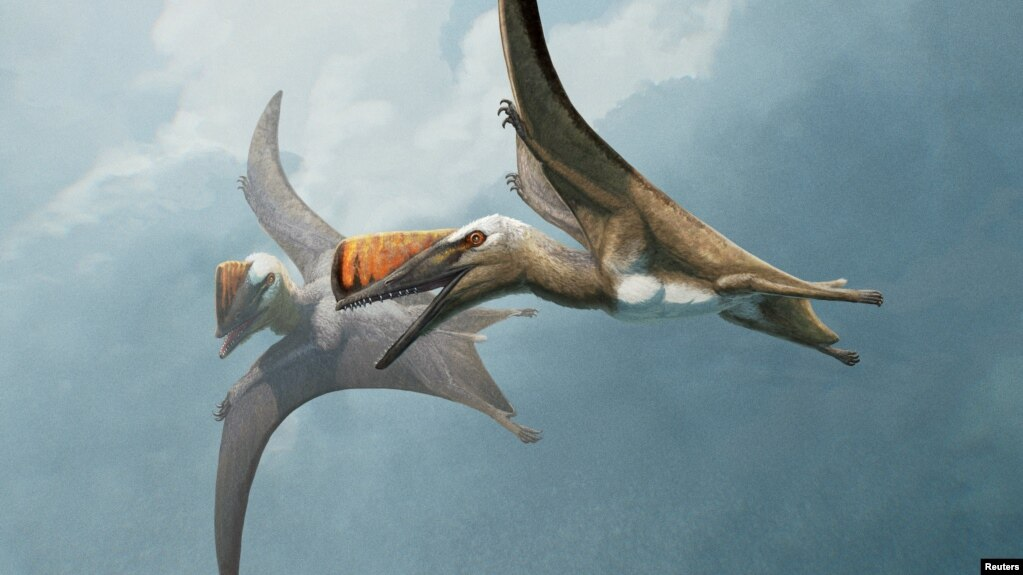Fossil from Germany Provides New Details about Ancient Flying Reptiles
Fossil from Germany Provides New Details about Ancient Flying Reptiles
今回は、ドイツ南部バイエルン州で発見された翼竜の化石についての記事です。約1億4700万年前に生きていた新しい種類の生物が確認され、恐竜時代の生態系や進化を理解する手がかりになると期待されています。文中の「identify」は「特定する、発見する」という意味で、identify a new species(新種を発見する) や identify a problem(問題を特定する) のように使えます。恐竜は人が誕生するはるか前から存在し、今も多くの謎に包まれています。あなたは恐竜の化石を実際に見たことがありますか?そのときの印象を講師と話してみましょう。

1.Article
Directions: Read the following article aloud.
Scientists say a fossil found in Germany is providing new details about flying reptiles that lived on Earth about 147 million years ago.
The fossil was discovered in 2015 in the southeastern German state of Bavaria. It contains the remains of a newly identified species called Skiphosoura bavarica.
Skiphosoura is considered a pterosaur, an ancient flying reptile. It lived toward the end of the Jurassic Period. Researchers say the creature played an important part in the development of ecosystems during the age of the dinosaurs.
The reptile had a wing reach of about 2 meters for traveling and a set of sharp teeth to help capture and eat other animals. Skiphosoura would have been one of the largest fliers in its ecosystem. Researchers say the discovered fossil was in good shape, with nearly every bone remaining in the skeleton. This has permitted the team to learn new details about this pterosaur.
One of the leaders of the fossil examinations is David Hone of Queen Mary University of London. He told Reuters news agency he thinks the fossil find was "of huge importance."
Hone was the lead writer of a study describing the team’s work in the publication Current Biology. He added that Skiphosoura has provided new information about the evolution of pterosaurs. "It also brings other pterosaur finds we had already made into focus,” Hone said.
He added that the discovery also helps better explain “where they go in the family tree of pterosaurs” and permits scientists to show this development from early to later forms.
"The teeth are quite long and sharp. They are for puncturing and holding," Hone said. He noted these were likely used to catch smaller animals such as lizards, small mammals, insects and possibly fish.
Pterosaurs are considered ancestors of the dinosaurs. They were the first of three groups of vertebrates – animals with a backbone – to enjoy powered flight. Pterosaurs disappeared about 66 million years ago in the mass extinction that also took out most of the dinosaurs after an asteroid struck Earth.
Scientists divide pterosaurs into two major groups - the early non-pterodactyloids and the later pterodactyloids. The early group's members had a short head, short neck, long tail and a long fifth toe on the foot. The later ones had a large head, long neck, short tail, long wrist and short fifth toe.
The team says the discovery of Skiphosoura – along with another species that lived 170 million years ago in Scotland – have helped shape important events in pterosaur development.
The fossil was discovered in 2015 in the southeastern German state of Bavaria. It contains the remains of a newly identified species called Skiphosoura bavarica.
Skiphosoura is considered a pterosaur, an ancient flying reptile. It lived toward the end of the Jurassic Period. Researchers say the creature played an important part in the development of ecosystems during the age of the dinosaurs.
The reptile had a wing reach of about 2 meters for traveling and a set of sharp teeth to help capture and eat other animals. Skiphosoura would have been one of the largest fliers in its ecosystem. Researchers say the discovered fossil was in good shape, with nearly every bone remaining in the skeleton. This has permitted the team to learn new details about this pterosaur.
One of the leaders of the fossil examinations is David Hone of Queen Mary University of London. He told Reuters news agency he thinks the fossil find was "of huge importance."
Hone was the lead writer of a study describing the team’s work in the publication Current Biology. He added that Skiphosoura has provided new information about the evolution of pterosaurs. "It also brings other pterosaur finds we had already made into focus,” Hone said.
He added that the discovery also helps better explain “where they go in the family tree of pterosaurs” and permits scientists to show this development from early to later forms.
"The teeth are quite long and sharp. They are for puncturing and holding," Hone said. He noted these were likely used to catch smaller animals such as lizards, small mammals, insects and possibly fish.
Pterosaurs are considered ancestors of the dinosaurs. They were the first of three groups of vertebrates – animals with a backbone – to enjoy powered flight. Pterosaurs disappeared about 66 million years ago in the mass extinction that also took out most of the dinosaurs after an asteroid struck Earth.
Scientists divide pterosaurs into two major groups - the early non-pterodactyloids and the later pterodactyloids. The early group's members had a short head, short neck, long tail and a long fifth toe on the foot. The later ones had a large head, long neck, short tail, long wrist and short fifth toe.
The team says the discovery of Skiphosoura – along with another species that lived 170 million years ago in Scotland – have helped shape important events in pterosaur development.
Reuters reported this story. Bryan Lynn adapted the report for VOA Learning English.
Source:Fossil from Germany Provides New Details about Ancient Flying Reptiles
VOA
本教材は、the U.S. Agency for Global Mediaより許諾を得て、産経ヒューマンラーニング株式会社が編集しています。
テキストの無断転載・無断使用を固く禁じます 。
